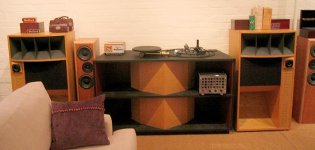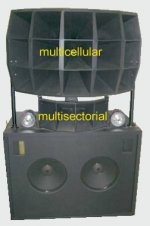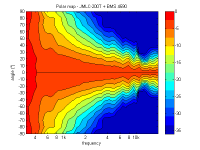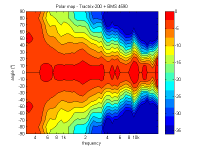Something I should of mentioned IMHO a multi cell and any horn for that matter a really strong throat is very important. For eg altec made there horns from tin but there throat's from brass. This is the failing of modern multi cell copies in my opinion there using wood throats. If I bought a abs horn for eg I would be reinforcing the throat with carbon fiber. If I ever was desperate enough to try make a multi cell I would buy a altec brass throat to start with. If you made a multi cell. You could make a removable throat to altec spec and see all the altec throats dry up on ebay so fast 😉
I have a pair of the OS12 in my room at the moment:
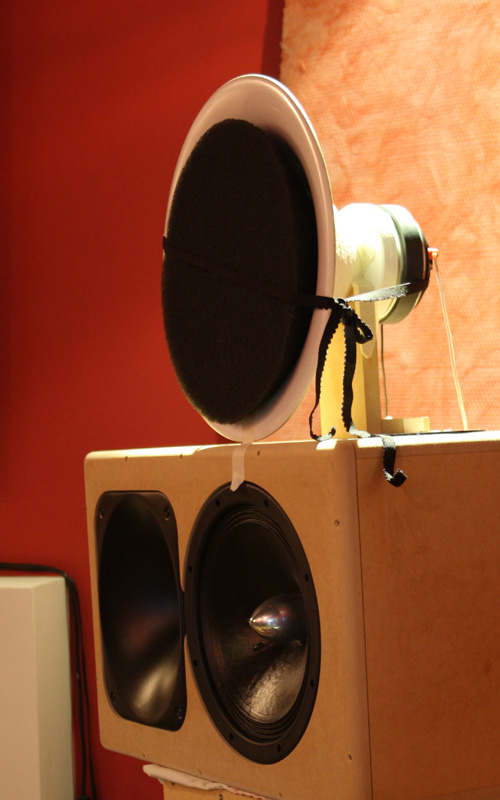
Very nicely made!
http://redspade-audio.blogspot.com/2011/04/deluxe-e-wave.html
Measured in this event:
http://redspade-audio.blogspot.com/2011/01/waveguide-shootout.html

Very nicely made!
http://redspade-audio.blogspot.com/2011/04/deluxe-e-wave.html
Measured in this event:
http://redspade-audio.blogspot.com/2011/01/waveguide-shootout.html
I have a pair of the OS12 in my room at the moment:

Very nicely made!
Red Spade Audio: Deluxe e-wave
Measured in this event:
Red Spade Audio: Waveguide shootout
Does the filter thingy help with the homs
I would like to have a go at the EJMLC 150hz. Suits my dispersion and compact vertical requirements. Ugly sucker but who cares. Have to paint it grey.
I have a pair of the OS12 in my room at the moment:

wouldn't it be easier to put some sponge into ears?

Did The EJMLC 150 ever get built? Btw I wasnt trying to be critical of these horns. I think there great!
I would like to have a go at the EJMLC 150hz. Suits my dispersion and compact vertical requirements. Ugly sucker but who cares. Have to paint it grey.
It's too large - over 2 meters wide. From what I see you need 100Hz biradial horn - Multicell is step back. E-JMLC-300 to be available after Hi-End Munich 2011.
Does the filter thingy help with the homs
It's reticulated foam and it does help a great deal, with quite a substantial improvement. Sadly it does take away some of the visual beauty of the waveguide - the OSWG12 looks fantastic before the foam goes in. A good compression driver in a decent waveguide with foam rivals a dome tweeter in smoothness and freedom from harshness and listening fatigue, but all of the advantages of waveguides and compression drivers are retained. There is a slight trade off where there is a small loss of detail. Overall it's a big step forward.
Red Spade Audio: Waveguide foam mod
Red Spade Audio: Miniwaves foam mod
wouldn't it be easier to put some sponge into ears?
Much easier, just like it's easier to break something than it is to fix it.
It's too large - over 2 meters wide. From what I see you need 100Hz bi radial horn - Multi cell is step back. E-JMLC-300 to be available after Hi-End Munich 2011.
I am thinking Iam not going to talk you into building multi cells am I? Please don't give up on multi cells. 100hz birradial would be a biggy. Bought some biradial tweeters today. evt350s. 200hz hz multi cell would do. Have a look at the living mid horns here. This is what I was trying to explain to you about a simplified multicell. I am sure there is a more appropriate name. E-jmlc-300sound interesting btw.
Attachments
I am thinking Iam not going to talk you into building multi cells am I? Please don't give up on multi cells. 100hz birradial would be a biggy. Bought some biradial tweeters today. evt350s. 200hz hz multi cell would do. Have a look at the living mid horns here. This is what I was trying to explain to you about a simplified multicell. I am sure there is a more appropriate name. E-jmlc-300sound interesting btw.
I think multi-cells create more problems than they solve. It was just an old school way of creating wider dispersion before the engineers figured out constant directivity and directivity control. I think everyone is better off with one of the designs already available then for Jack to make a multi-cell design only one or two people are interested in.
Hello
What you show on the pîcture are most probably multisectorial horns.
Here attached a picture of the 4ways Onken system with a low-mid multicellular horn and a mid multisectorial horns.
Best regards from Paris, France
Jean-Michel Le Cléac'h
Have a look at the living mid horns here. This is what I was trying to explain to you about a simplified multicell.
What you show on the pîcture are most probably multisectorial horns.
Here attached a picture of the 4ways Onken system with a low-mid multicellular horn and a mid multisectorial horns.
Best regards from Paris, France
Jean-Michel Le Cléac'h
Attachments
Difference between particular angle (30deg) and sum of 0-60deg. Do we see some Bessel modes?
What happened to the response of SEOS-15 below 3000 in this sonogram? It seems to have dropped off considerably.😱
It's reticulated foam and it does help a great deal, with quite a substantial improvement. Sadly it does take away some of the visual beauty of the waveguide - the OSWG12 looks fantastic before the foam goes in. A good compression driver in a decent waveguide with foam rivals a dome tweeter in smoothness and freedom from harshness and listening fatigue, but all of the advantages of waveguides and compression drivers are retained. There is a slight trade off where there is a small loss of detail. Overall it's a big step forward.
Red Spade Audio: Waveguide foam mod
Red Spade Audio: Miniwaves foam mod
Much easier, just like it's easier to break something than it is to fix it.
Its important to note that foam helps in some cases more then others.
What happened to the response of SEOS-15 below 3000 in this sonogram? It seems to have dropped off considerably.😱
Most likely time shift between impulses. Below first attempt to Bi-radial horn.
Attachments
Hi, Im new here and just posted this
http://www.diyaudio.com/forums/construction-tips/186543-iwata-tad-4003-a.html
We are on the verge of making a Iwata for the TAD 2003 and I made some investigation into the difference between the 4001 and 03. Maybe it's of interest.
Sincerely thanks for so many great input's (why has the day so few hours).
Regards
Peter
http://www.diyaudio.com/forums/construction-tips/186543-iwata-tad-4003-a.html
We are on the verge of making a Iwata for the TAD 2003 and I made some investigation into the difference between the 4001 and 03. Maybe it's of interest.
Sincerely thanks for so many great input's (why has the day so few hours).
Regards
Peter
what would be a recommended horn for electro voice DH1A run from say 500hz onwards?
price please too
price please too
I think multi-cells create more problems than they solve. It was just an old school way of creating wider dispersion before the engineers figured out constant directivity and directivity control. I think everyone is better off with one of the designs already available then for Jack to make a multi-cell design only one or two people are interested in.
Having heard 805s, 1505s and some other large format multi-cell in a few home applications, I can't agree with you more than I do. I have heard them work quite respectably sitting 30 rows from the stage at a theater, but I have yet to be impressed in a home setting.
Hello
What you show on the pîcture are most probably multisectorial horns.
Here attached a picture of the 4ways Onken system with a low-mid multicellular horn and a mid multisectorial horns.
Best regards from Paris, France
Jean-Michel Le Cléac'h
Jean-Michel Le Cléac'h I have probably mis written your name maybe 500 times so please forgive my ignorance if you ever come across an example. I will try harder in future. I have a azuru 150 hz horn with your profile. I just put a sticky on my monitor in the hope it wont happen again. I will try this for martians azuru next.
Yes multisectorial horns is what I was trying to demonstrate.I love both multisectorials(new sticky too) and multicellular.
I wonder if you can help me jean Michel in the past week I have lost a little faith in compression drivers. Mike bates opinion was one that made me rethink. He was referring to the audax PR170mo mid driver and how good it can be with and with out a horn and in pairs and that he eventually tired of compression drivers as being too brash in the end.
A local speaker repair said I was immature for even trying to use them at all. He quoted that some have 50% distortion anyway. I have decided to try build more cone driven horns and less compression driver horns and concentrating on low compression 1.1 in my cone driven horns and also experimenting with high efficiency direct radiator speakers. Something based of twin Audax PR170M0 6.5" and drivers of similar efficiency for the rest of the spectrum. I guess horn tweeters are unavoidable. I was looking at low mid compression drivers in the 2 inch class now I have decided to stick with the 4 pair of 1 inch drivers I have for upper mid for the time being and not try to get anything above 12 k from them before switching to ring radiators and building small cone driven horns for the lower mid. Then bigger cones for bass horn and then tapped horn for low end.
Do you think there is some rational to the idea that horn speakers while class leading dynamically ultimately are fatiguing to listen to or is it more likely a result of poor application and or source material. You have heard more systems then I could ever dream of listening too. I live in a remote part of Australia. I listen to what I build. Maybe the reason I build so many systems and amps. I guess this is a bit of a loaded question thus the reason I thought I wouldn't sneakily ask it hear where nobody looking. 😉 I have a jbl 2226's and altec 288's and 1" some ev's and toa's This is the standard of compression drivers I would have access to. Not yl goto or onken. Maybe those ones are completely fatigue free when run 5 and 6 way. I build decent dht amps too.
You think I should keep the faith? Or head in the direction stated above. I wont be offended Jean-Michel if its inappropriate to answer this. It's definitely of topic.
https://www.madisound.com/store/product_info.php?products_id=90
Last edited:
- Home
- Group Buys
- Waveguides and horns
